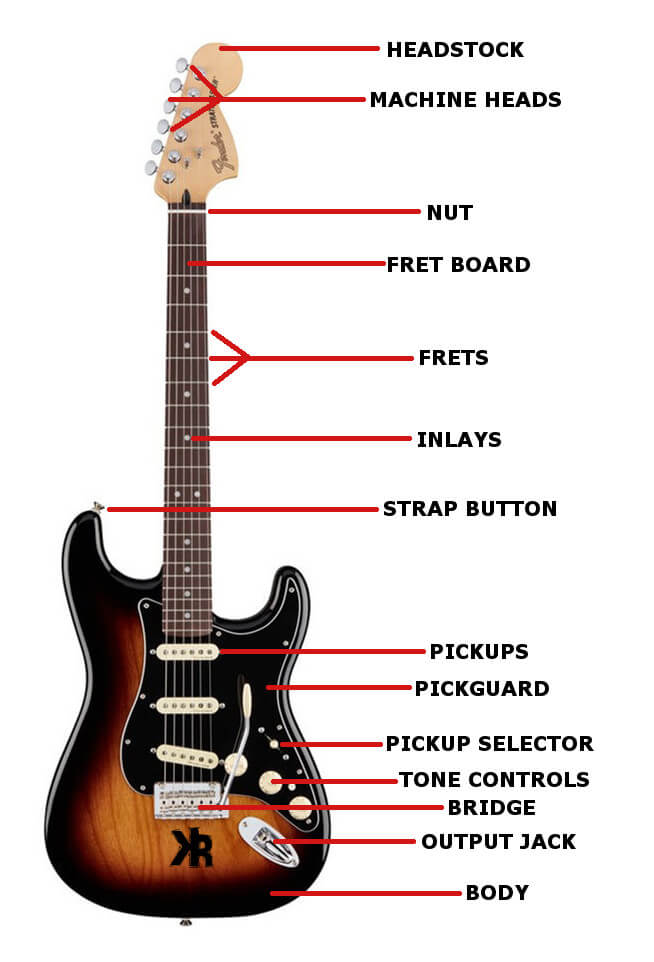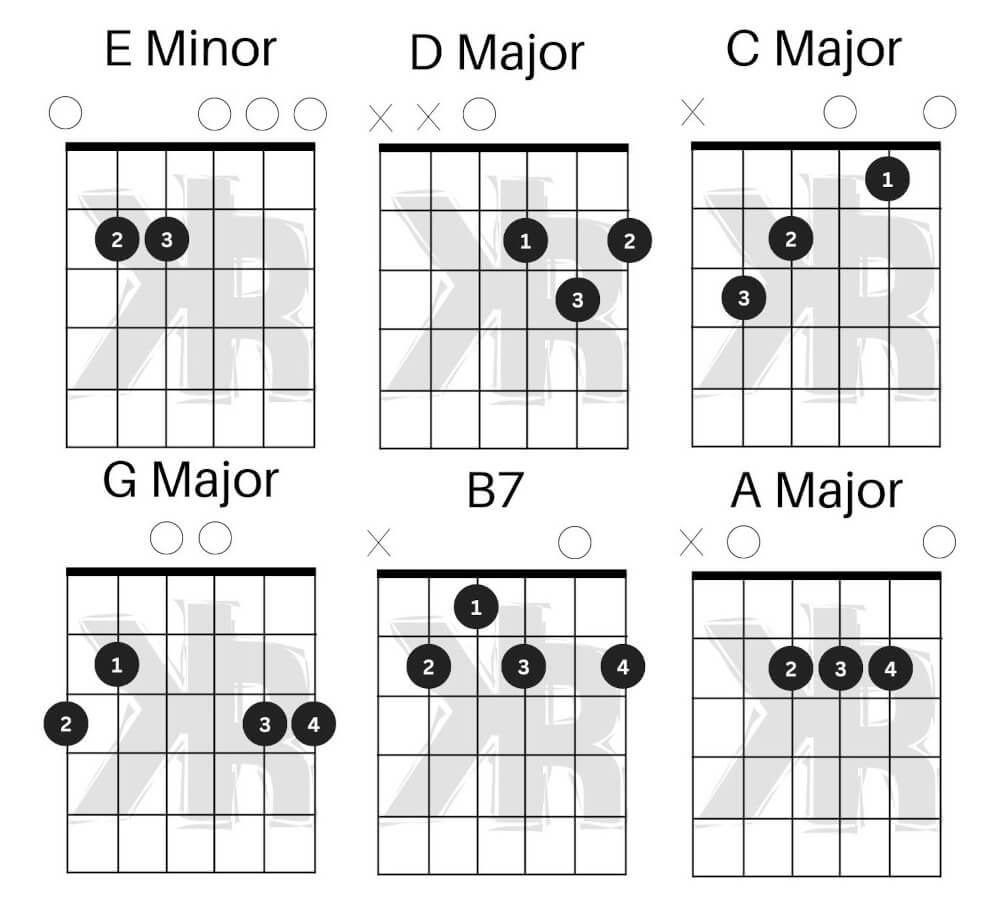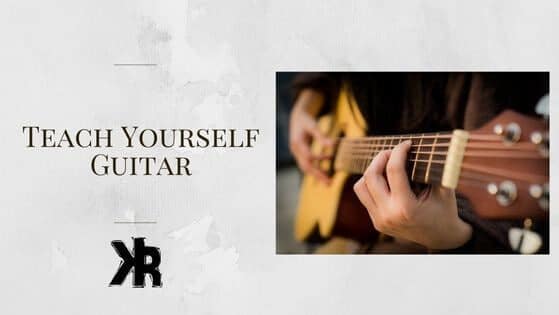Table of Contents
If you have a guitar and are considering learning how to play, you may be weighing the options of formal lessons versus self-instruction. Lessons can be expensive and time-consuming. It might be best to teach yourself.
This Killer Rig article provides a comprehensive guide on how to teach yourself guitar. It covers essential tools, basic techniques, practice schedules, and additional resources for continuous learning.
The aim is to equip you with the knowledge needed to start your journey in becoming a self-taught guitarist.
Teaching Summary
- Find a good guitar: Choose a guitar that feels comfortable to play and suits your style of music.
- Learn the fundamentals: Learn the basic chords, how to strum and hold the guitar.
- Create an ideal learning environment: Find a quiet and comfortable space to practice, with all the necessary equipment.
- Build skills by learning songs: Start with easy songs and gradually work your way up to more challenging ones.
- Practice regularly: Set aside time each day to practice, even if it’s just for a few minutes.
- Use online resources: There are many online resources available, such as YouTube tutorials and guitar lesson websites.
- Join a community: Joining a guitar community can provide support and motivation, and give you the opportunity to learn from others.
- Record yourself: Recording yourself playing can help you identify areas where you need to improve.
- Get feedback: Ask friends or family members to listen to you play and provide feedback, or consider taking lessons with a local guitar teacher.
- Be patient: Learning to play guitar takes time and practice, so be patient and enjoy the journey.
Related Articles
Choosing the Right Guitar
So, you’ve made the decision to start a new journey in the world of guitars. That is excellent! It’s one you will not regret! But wait, before you start strumming those strings, there’s a rather large decision to be made. A crucial one at that! The type of guitar should you choose.
Guitars, you see, come in so many different shapes and sizes. There’s the acoustic and the electric, with nylon-string and steel-string variations. Each has its own personality, its own voice. And the one you choose? Well, it should match your voice, your style.
Think about the music you love. The songs that make your heart beat a little faster. Is it the soulful strumming of an acoustic folk song? Or the electrifying riffs of a rock anthem? Your music preference, it matters. It’s a compass guiding you to the right guitar.
Nylon-string acoustic guitars, they’re a gentle introduction to the guitar world. Easy on the fingers, they’re perfect for beginners. But if folk or country songs are your jam, a steel-string acoustic guitar might be your best bet.
On the flip side, if rock or metal sets your pulse racing, an acoustic guitar might not cut it. You might need the amplified sound and diverse effects of an electric guitar to truly express your musical soul.
But here’s the thing. Don’t just go for what’s easy. Go for what feels right. The guitar you choose should inspire you, fuel your passion. It should make you want to pick it up and play, day after day.
So, take your time. Listen to your heart. Choose the guitar that not just fits your fingers, but also your soul. Because learning the guitar? It’s not just about mastering an instrument. It’s about creating music that’s uniquely you.
Read my article on acoustic vs electric guitars.
Understanding the Basics
So you’ve found your guitar. Wonderful! Doesn’t it just feel right somehow? The weight of it in your hands and the strings under your fingers.
But there’s something crucial you need to do before you start producing or play music with it. Understand it. Know it. Because the guitar isn’t just an instrument. It must become an extension of you.
Let’s start where everyone else does, with the basics. The parts of the guitar. There’s the headstock, the neck, the body. Then there are the strings, the frets, the pick. Each part, it plays a role in creating the melody that is uniquely yours.

Next, tuning. It’s like setting the stage before the performance. Each string, it needs to be in harmony with the others. Too tight, and the melody is sharp. Too loose, and it’s flat. The right tuning, it’s the first step to a perfect performance.
If you need help, use our free online tuner here!
Now, the strings. They’re not just strings. They’re the six notes that form the basis of all music. E, A, D, G, B, E. Learn them. Know them. Because these six strings, they’re the keys to unlocking the world of music.
Frets, you ask? Think of them as the roadmap to your melody. Each fret changes the pitch of the string. The farther up the neck you go, the higher the pitch gets. It’s like climbing a ladder. Each step, it takes you higher. By pressing down on a fret, you change the note as a result!
And the pick? It’s your tool, your paintbrush. It’s what you use to create your melody. Hold it right, and it will dance on the strings, creating a melody that’s smooth and flowing. There are many types of picks, but I would suggest you start with something basic.
Read my article on the different types of picks!
Mastering the Fundamentals
So, you must be familiar with your guitar a bit by now. You’ve tuned it and strung it, maybe even given it a hug. You’re prepared to play now.
But wait! There’s a step you really shouldn’t skip. The fundamentals. They’re like the foundation of a house. You need to build them strong to support everything that comes next.
Chords
Let’s start with chords. They’re like the building blocks of music. Each chord, it’s a combination of notes played together.
And when you strum them right, they create a harmony that’s pure magic. Start with the basic ones. G, C, D, E, A. Practice them, master them. Because these chords, they’re the start of your musical journey.

Strumming
Strumming is the rhythm of your song. The beat that gets your foot tapping. And it’s not just about strumming down. It’s about strumming up, too. It’s about finding your own individual beat.
Combining downstrokes with upstrokes and applying a beat gives a guitar song its structure. These alternate strumming patterns are used on many popular songs. So before you rush into guitar solos, master the art of strumming!
Scales
And then there are scales. They’re like the roadmap to your melody. Each scale, it’s a sequence of notes. And when you play them right, they create a melody that’s smooth and flowing.
Start with the basic ones. The major scale, the minor scale. Practice them, master them. Because these scales, they’re the keys to unlocking the world of guitar music.
Spend a good amount of time here and master these fundamentals. Practice them until they become second nature. Because the guitar, it’s not just about playing. It’s about creating music that’s a reflection of you. And the better your fundamentals, the better your music will be.
Learning to Play Songs
You’ve laid the groundwork. You’ve built the foundation. Now comes the ultra fun part. Playing songs! It’s what inspires most players to want to pickup the guitar in the first place. Start with your favorite songs. The ones that make your heart sing. The ones that you can’t help but tap your foot to.
Because when you play a song you love, it’s not just practice. It’s joy. It’s passion. And that’s what music really should be all about anyway. But how can one master a song? Choose a song that is understood to be very simple for a beginner to handle first.
By now, you should be familiar with a number of the fundamental chords, which will be very useful. Then, listen to and study the song. No, really listen. Hear the chords, the rhythm. Feel the music. Then, pick up your guitar. Try to play along.
You can also make use of song tablature to help you figure out which chords or notes are being used by the artists. Then, practice! It’s the master key. It’s the fuel that drives your journey. So, make time for it every single day. Even if it’s just for 30 minutes.
Because every strum, every chord, it’s a step towards your goal. But don’t just practice. Record yourself. Listen to it. Hear your mistakes, your triumphs. Because when you listen to yourself, you become your own teacher.
You learn, you improve. So, pick up your guitar. Play your favorite song. Make mistakes, learn from them. Because learning to play songs, it’s not just about practice. It’s about enjoying the journey. It’s about creating music that’s uniquely you.

Advanced Techniques
It’s crucial to explore more complex techniques as you continue in your guitar studies. This is because they can improve your playing and increase your musical horizons. Here are some helpful examples of these strategies:
Reading Chord Charts
Chord charts provide a visual representation of the guitar fretboard, indicating where to place your fingers to play specific chords.
Understanding chord charts can significantly speed up the process of learning new songs and experimenting with different progressions.
Understanding Guitar Tabs
Guitar tablature, or tabs, is another form of musical notation specific to stringed instruments. Tabs can be particularly useful when trying to learn more complex riffs, solos, or fingerpicking patterns.
They provide a detailed guide for finger placement on the fretboard, making it easier to tackle intricate pieces of music.

Exploring Video Tutorials
Video tutorials can be an invaluable resource for learning advanced techniques. They offer visual and auditory cues that can help you grasp more complex concepts, such as alternate picking, bending, sliding, or hammer-ons and pull-offs.
Additionally, watching other guitarists play can provide insights into different playing styles and techniques that you might not encounter otherwise.
Practicing with a Metronome
A metronome is a tool that produces a steady beat to help musicians play rhythms accurately. Practicing with a metronome can improve your timing and rhythm, essential skills for any guitarist, especially when playing with others or along with a track.
Use our free online metronome here if you need help.
Practicing with Others
While self-learning is a rewarding process, practicing with others can provide a different set of benefits. Here’s why and how you should consider incorporating it into your learning journey:
- Learning from Peers: You may be exposed to radical techniques and different styles by playing with other guitarists. You can gain knowledge from their experiences, receive feedback on your own playing, and pick up new strategies that you might not have thought of on your own.
- Improving Timing and Rhythm: Playing in sync with others requires a strong sense of timing and rhythm. This practice can help you improve these skills, which are crucial for any musician.
- Building Confidence: Practicing with others is also an excellent confidence builder! It provides a safe space to make mistakes, learn from them, and improve.
- Expanding Musical Knowledge: Other musicians can introduce you to new music genres, artists, and songs, expanding your musical knowledge and influences.
- Online Forums and Communities: If you don’t have other musicians nearby, online guitar forums and communities can be a great alternative. You can share your progress, ask for advice, discuss guitar-related topics, and even find online jam partners.
Incorporating social elements into your learning process can make it more enjoyable and enriching. Whether it’s in-person jam sessions or online discussions, interacting with other guitar enthusiasts can significantly enhance your learning journey.
Do’s and Don’ts of Teaching Yourself Guitar
As you strum your way through this exciting journey of self-learning guitar, there are certain practices to embrace and pitfalls to avoid. Let’s explore some of these do’s and don’ts.
Do Warm Up: A guitarist shouldn’t launch into intricate riffs without warming up their fingers, just as an athlete wouldn’t sprint without a full warm-up. A few minutes of finger exercises can go a long way in preventing strain and improving agility.
Don’t Rush: Learning guitar is not a race. It’s a marathon. It’s easy to get impatient and want to play like Eddie Van Halen right away! But remember, even he had to start with the finger pain and fundamental basics in the beginning. So, take it slow. Get a good grasp of each step before moving on to the next.
Do Practice Regularly: Consistency is key when learning an instrument. Even a brief daily practise session can be more advantageous than irregular, extended sessions. Make guitar practice a part of your daily routine.
Don’t Neglect Theory: While it’s tempting to focus solely on playing, understanding music theory can enhance your playing skills and musicality. It gives you a better understanding of what you’re playing and creates fresh improvisational and compositional opportunities.
Do Set Realistic Goals: Setting achievable goals can keep you motivated and provide a sense of accomplishment. Whether it’s mastering a new chord each week or learning a new song each month, having clear objectives can guide your practice sessions.
Don’t Forget to Enjoy the Process: Above all, remember why you picked up the guitar in the first place. For the love of music. So, enjoy the process. Celebrate your progress. And keep the joy of playing alive.
Learning guitar is a journey filled with challenges and triumphs. Embrace the process, learn from your mistakes, and keep strumming. The world of music awaits.
Common Mistakes and How to Avoid Them
By being aware of these pitfalls, you can take proactive steps to ensure a more effective and enjoyable learning experience.
Incorrect Finger Placement
- Mistake: Placing fingers too far from the frets or not using the fingertips.
- Solution: Ensure fingers are close to the frets and use fingertips for a cleaner sound.
Inconsistent Timing
- Mistake: Rushing through scales or songs, leading to uneven tempo.
- Solution: Use a metronome to maintain a consistent tempo while practicing.
Neglecting to Tune the Guitar
- Mistake: Playing an out-of-tune guitar, which affects the sound quality.
- Solution: Regularly tune the guitar before practice sessions using a tuner.
Overlooking Basic Techniques
- Mistake: Jumping into complex songs without mastering basic techniques like strumming and chord transitions.
- Solution: Focus on mastering the basics before progressing to more complicated pieces.
Inadequate Practice
- Mistake: Not practicing regularly or for sufficient durations.
- Solution: Establish a consistent practice schedule and stick to it.
Ignoring Musical Theory
- Mistake: Focusing solely on the physical aspects of playing without understanding the theory behind it.
- Solution: Incorporate basic musical theory into your learning process for a well-rounded understanding.
Poor Posture
- Mistake: Practicing with poor posture, leading to discomfort or injury over time.
- Solution: Maintain a straight back and relaxed shoulders while playing to avoid strain.
Lack of Goal Setting
- Mistake: Practicing without clear objectives or milestones.
- Solution: Set achievable goals and track your progress to stay motivated.
Conclusion
And there you have it. A roadmap to navigate the exciting journey of teaching yourself guitar. From choosing the right instrument and understanding the basics, to mastering the fundamentals and exploring advanced techniques, each step is a milestone on your path to becoming a guitarist.
Keep in mind that the journey is entirely yours. How quickly you can play a song or how many chords you can learn in a week are not important factors.
It’s about using music to express yourself. It’s about the satisfaction you experience when you pluck the strings and create a song that expresses who you are.
So, keep practicing. Keep exploring. Keep playing. Because every strum, note, and chord is a step closer to your goal. And with passion, perseverance, and the right guidance, there’s no limit to what you can achieve.
Here’s to your musical journey. May it be filled with beautiful melodies, exciting discoveries, and above all, the joy of creating music.
Frequently Asked Questions
Is it ever too late to learn guitar?
Absolutely not! Any stage of life is the perfect time to pick up and start learning how to play the guitar. Whether you’re a teenager, a young adult, or even in your golden years. It’s never too late! So if you have peaked an interest, take it up and begin learning, regardless of your age!
The essential components are enthusiasm, commitment, and a readiness to learn. Remember that many well-known guitarists began their musical careers much later in life, demonstrating that there is no age limit when learning this wonderful instrument.
How hard is self-taught guitar?
The difficulty of self-teaching guitar can vary greatly, depending on several factors. This includes your prior musical experience, the amount of time you can allocate to practice, and the tools and resources you use for learning.
Yes, it can be quite challenging in the very beginning. But the rewarding experience down the road is so worth it! With the wealth of resources available today, from online tutorials and chord charts to interactive apps! Self-teaching guitar has become more accessible than ever.
Remember, consistency is key. Regular practice, patience, and a positive mindset can make the journey of self-learning guitar a fulfilling and enjoyable experience.

